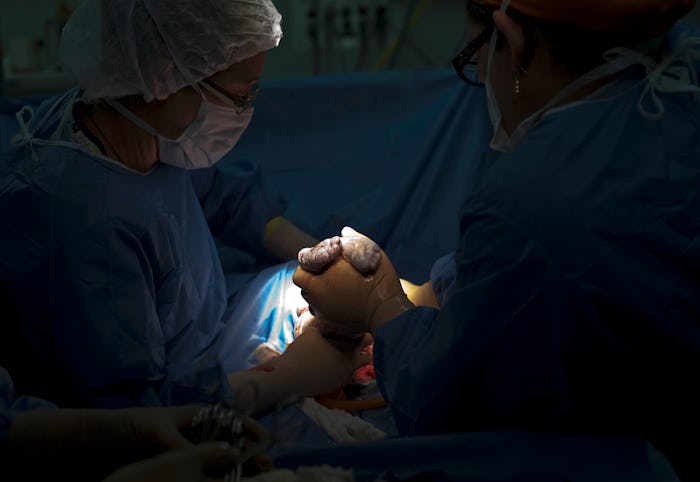Life

Why Is The US So Addicted To C-Sections? Rates For The Procedure Keep Going Up
Cesarean sections — more commonly known as just C-sections — is when a baby is delivered via surgery, often times in an emergency situation where the life of the mother or baby could be in danger, or when a woman is having multiple babies. But in the United States, half of babies are born via C-section; a rate that is much higher than in other parts of the world. So, why is the U.S. so addicted to C-sections? Why do many woman elect to have them — and why do hospitals agree to perform them, even when they aren't strictly necessary?
Each year, the Centers for Disease Control publishes information on all the births that occurred in the U.S. the previous year. This report includes several "vital statistics," including the average age of the mother, the number of preterm births, the number of births in young women between the ages of 15 and 19 and, of course, the rate of C-sections.
The most recent available data from 2014 showed that, while rates of C-sections have declined from previous years, they were still much higher than in other parts of the world — and much higher than they were in the U.S. just a few decades ago. In 1970, the C-section rate was just 5 percent. Today, it's 20 percent.
The one maternal age group that has continued to see a rise in C-sections is women over 40, who are twice as likely as women in their 20s to have a C-section. This may be because women who get pregnant over the age of 35 are considered "high-risk," which could include everything from preterm birth, to low birth weight, to complications like a breech positioned birth or preeclampsia.
But some research suggests that, while C-sections are meant to be preventative in the case of high-risk pregnancies and births, they might not actually provide better outcomes. Despite the high rate of C-section births, the maternal mortality rate in the U.S. has climbed for the last decade, settling in at 14 percent in recent years, according to data presented by the United Nations.
Why So Many C-Sections?
One reason researchers think there has been a rise in C-sections is that technological advances provide up-to-the-minute information on fetal vital signs from the moment a woman sets foot in the hospital — if not sooner. While it's theoretically great to have that much information pouring in in real time, many healthcare professionals (not to mention family, friends, and the mom-to-be herself) don't know how to interpret the readings.
If there's a blip on the fetal heart monitor, for example, it may prompt a nurse or attending doctor to reason the baby is in distress, even though they may not be. Throughout labor and delivery there are variations in the vital signs of both mom and baby, who are undergoing some pretty intense physiological stress. The question is, how much stress is harmful? How much stress warrants an emergency intervention, such as a C-section?
Another reason is directly related to the first: what if a doctor doesn't act when it looks like a baby or mother might be in distress? What if they don't perform a C-section and there are fatal consequences? Doctors get sued a lot, and so many doctors therefore feel the need to make decisions for their patients that are more proactive than reactive — but sometimes that means performing a procedure that is costly and unnecessary.
Malpractice suits stemming from childbirth experiences are not at all uncommon and 85 percent of the doctors who were sued in 2015 were OB-GYNs. Beyond that, the top reason they were sued? Their patients said that they failed to diagnose a condition or the patient suffered an abnormal injury as a result of the doctor's performance (both 31 percent).
Some Women Choose C-Sections
Women are also choosing to have elective C-sections at higher rates than they used to. A study by the American Congress of Obstetricians and Gynecologists reported that, while the exact rates of such requests aren't well known, in their work they found it to be at least 2.5 percent of all births.
The reasons women request C-sections? They are as varied as any other birth experience, and include everything from a history of complicated births with previous pregnancies to wanting to avoid incontinence post-delivery as a result of vaginal tearing.
While it is true that many women have the ability to have an elective C-section, it's also important to remember that many woman don't get the choice. It can be quite traumatizing to have a C-section in an emergency, and many women who have C-sections worry that they will not be able to deliver vaginally if they get pregnant again.
Whether C-sections are a choice, they are a major surgery and women should be aware that the recovery period can be quite long, and like any surgery, the procedure has risks.